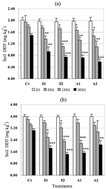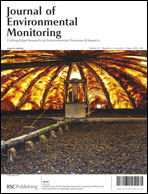Effects of two ecological earthworm species (epigeic Eisenia foetida and endogeic Amynthas robustus E. Perrier) with different densities (15 and 30 individuals per kg of soil) on the removal of soil 1,1,1-trichloro-2,2-bis(4-chlorophenyl)ethane (DDT) with two pollution levels (2 and 4 mg kg−1) were investigated. Concentrations of DDT and its metabolites, including 1,1-dichloro-2,2-bis(4-chlorophenyl)ethane (DDD), 1,1-dichloro-2,2-bis(4-chlorophenyl)ethylene (DDE), and 1-chloro-2,2-bis(4-chlorophenyl)ethylene (DDMU), were monitored after 60, 180, and 360 days of incubation. The results obtained showed that both earthworm species can significantly enhance degradation of soil DDT to its metabolites. For E. foetida, the higher earthworm density showed significantly higher rate of DDT degradation than the lower one. Anaerobic reductive dechlorination was the main degradation pathway over 180 days of incubation, while the aerobic dechlorination process was promoted between 180 and 360 days of incubation. Some earthworm amended treatments showed significantly higher microbial biomass carbon and nitrogen than the control, which suggested that earthworms might enhance the microbial degradation of DDT. Both earthworm species would have the potential to be applied to enhance the remediation of agricultural lands polluted by DDT.


 Please wait while we load your content...
Please wait while we load your content...